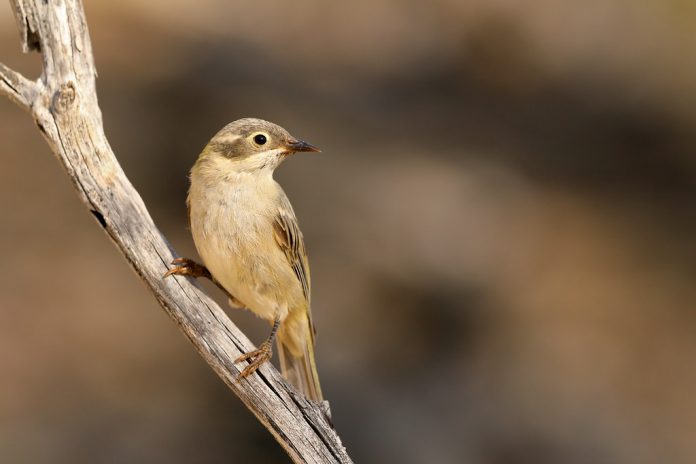Brown-backed Honeyeater (Ramsayornis modestus) is widespread across southern New Guinea. It is a species of bird in the family Meliphagidae. The Brown-backed Honeyeater is limited in Australia to wetter, riverside woodland, vine thicket, and paperbark swamps in coastal northeastern Queensland.

There it is nomadic and probably migratory. Loose flocks arrive along the coast between Cook town and Townsville to breed in August-September and leave in April-May. At the same time, they withdraw from drying swamps on the Cape York Peninsula, suggesting that most fly to New Guinea in winter.
Maybe they move at night because no passage migrants have been recorded on Torres Strait islands so far. Members of traveling bands keep in touch with one another by continually calling, mik, mik, mik. On their breeding grounds, Brown-backed Honeyeaters spread out in pairs to nest along well-shrubbed waterways.
Brown-backed Honeyeater habitually associates in dispersed colonies, where the proximity of nests may aid efficient food gathering and also parasitism by the birds’ chief host, the Brush Cuckoo. In northeastern Queensland-but rarely elsewhere-Brush Cuckoos lay white, black-speckled eggs that intimately mimic those of the Brown-backed Honeyeater.
Feeding alone or in dispersed groups, Brown-backed forage much on insects gleaned from foliage, from under bark on branchlets, and, particularly, on the wing in short hawking sallies. The birds work from low shrubbery to the tops of trees. Nectar is also rifled from blossom, mostly from flowering paperbarks Melaleuca, Black Bean Castanospermum, and Calophyllum. Brown-backed mix then with other feeding honeyeaters, such as Brown and Dusky.
It is also known as the Unadorned Honeyeater or Modest Honeyeater. The size of the Brown-backed Honeyeater is about 120-130 mm in length. Both sexes are similar. The adult upper parts are warm brown, faintly lined on the crown, and mottled on the back with dusky. However, the wings and tail are darker and grayer brown.
Face warm brown, with short cream-white bar under eye; obscure brown malar line. Underparts uniformly white; creamier and scalloped faintly brown on breast; flanks faintly streaked brown. The eyes are red-brown, with a bill of deep brown flesh. The feet are brown-flesh. They are immature as adults but back-washed ochreish; breasts are strongly streaked brown.
Brown-backed Honeyeater call is sharp chit when feeding, rapidly repeated, perhaps in alarm; repeated, soft mik, mik, mik, mik in contact inflight. Brown-backed Honeyeater song is lively chattering sheee-sheeesheee- sheee. The nesting and breeding months are August-March. Nest a rough, deep cup, roofed over at the top, of strips of melaleuca bark; lined with finer strips; hung from twigs and foliage, more often than not two to four meters above the water.
Nest either solitary or in loose colonies of up to 17-20. The birds lay two-three matt white, eggs unmarked or very sparsely spotted with minute black dots which sometimes form a dark cap at the larger end; tapered-oval to long oval, about 20 x 13 mm.
Brown-backed Honeyeater is found in paperbark swamps, mangroves, riverine vegetation, and eucalypt woodland in coastal northeastern Queensland from the tip of Cape York to Ayr. Also in southern lowland New Guinea and offshore islands, including Aru Islands.
Related Reading – Tawny-crowned honeyeater







